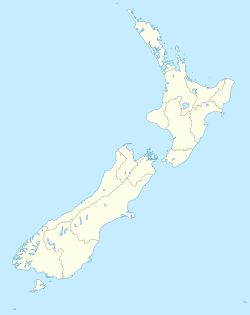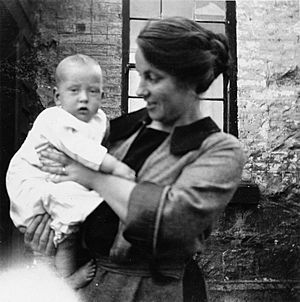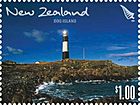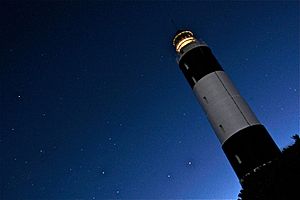Dog Island Lighthouse facts for kids
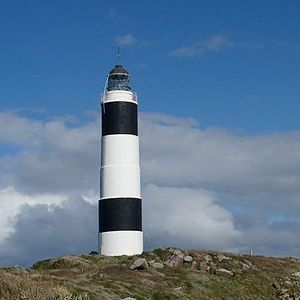 |
|
| The Dog Island Lighthouse in 2011 with its distinctive stripes | |
|
|
|
| Location | Dog Island, Foveaux Strait, New Zealand |
|---|---|
| Coordinates | 46°39′07″S 168°24′38″E / 46.65190°S 168.4105°E |
| Year first constructed | 1865 |
| Automated | 1989 |
| Construction | stone tower |
| Tower shape | cylindrical tower with balcony and lantern |
| Markings / pattern | white tower with two black bands, black lantern dome |
| Height | 36 metres (118 ft) |
| Focal height | 46 metres (151 ft) |
| Range | 19 nautical miles (35 km; 22 mi) |
| Characteristic | FI W 10s. |
| Admiralty number | K4394 |
| NGA number | 5428 |
| ARLHS number | NZL-019 |
The Dog Island Lighthouse stands on Dog Island in Foveaux Strait. It is New Zealand's tallest lighthouse and one of its oldest. It's special because it's built from stone. This lighthouse was designed by a famous engineer. It was the first lighthouse in New Zealand to have a light that spun around. Its first light system worked for 60 years.
The Dog Island Lighthouse is easy to spot with its black and white stripes. Only two other lighthouses in New Zealand have stripes like it. It is a very important historic building. It is listed as Category I by Heritage New Zealand. The old house next to it, where the keepers lived, is also historic (Category II). It used to have three lighthouse keepers living there. But since 1989, it has been controlled by computers from Maritime New Zealand's Wellington office. No one lives on Dog Island anymore. The Dog Island Lighthouse has even been on New Zealand stamps twice!
Contents
Why a Lighthouse Was Needed
It was clear that a lighthouse was needed in Foveaux Strait. This is a busy stretch of water. In the 1860s, people talked a lot about where to put it. Sea captains who knew the area well were asked for their ideas. They suggested places like Centre Island, Ruapuke Island, Stewart Island, Solander Islands, and Dog Island.
Dog Island was chosen as the first lighthouse site for the Southland area. The Harbour Master in Invercargill suggested it. He told James Alexander Robertson Menzies, who was the first leader of the Southland Province, that Dog Island was dangerous. He said, "it is very low and not seen till close upon it." At that time, the Southland Province had just separated from the Otago Province. Both local governments were involved. There was some confusion about who would build it. In the end, the main government decided to build all lighthouses across the country.
Building the Lighthouse
James Balfour was asked to design the lighthouse in 1863. He was a marine engineer. Balfour ordered the lighthouse parts and the light system from Edinburgh. They came from a famous lighthouse designer named Alan Stevenson. Balfour had learned from Stevenson's brothers, David and Thomas Stevenson. Thomas Stevenson was also Balfour's brother-in-law.
The equipment arrived in Port Chalmers on September 3, 1863. It came on a ship called City Of Dunedin from Glasgow. The light system arrived later, on March 17, 1864, on the ship Resolute.
Dog Island is a low, rocky island. Its highest natural point is about 15 metres (49 ft) above sea level. To be effective, the lighthouse needed to be about 110 feet (34 m) tall. This meant it had to be built very high. People found enough rock on the island to build the tower. Building such a tall tower from steel would have been too expensive.
Balfour designed the tower to be 36 metres (118 ft) tall. It was 6.6 metres (22 ft) wide at the bottom. It was 5.0 metres (16.4 ft) wide just below the balcony. The light was placed 30.5 metres (100 ft) high. Balfour also designed two houses for the lighthouse keepers and their families. The total cost was about £10,480. This was much more than the usual cost for lighthouses back then.
The light system was special because the island was so remote. Instead of one central lamp, it used sixteen lamps. These lamps were arranged in four groups. Each lamp had its own mirror. The lamps were on a square frame that spun around every two minutes. This made the light flash every 30 seconds. This design was clever because if one lamp failed, the others would still work. It was also easy to fix. This was the first spinning light system in New Zealand.
Lighthouse History
The lighthouse first started working on August 5, 1865. Within a year, people noticed the tower swayed a lot in strong winds. This was because the ground underneath was soft and peaty. The tower also started to lean a little. During storms, water leaked badly into the tower. In 1867, weak mortar between the stones was replaced with Portland cement. At the same time, the tower was painted with a large white stripe in the middle. The rest was painted black. This made the tower easier to see during the day. It also helped to keep water out. This black and white pattern has stayed the same ever since.
In 1871, a crack appeared at the bottom of the tower. The Marine Engineer ordered it to be fixed right away. Workers used strong wood and wrought iron bands to strengthen it. This work was hard because of bad weather. It cost about £978. By 1916, more major strengthening was needed. The old cement was failing. Plans were made to add a 2 feet (0.61 m) thick layer of reinforced concrete to the outside. This went up to just below the balcony. A 6 inches (150 mm) thick reinforced concrete lining was also added inside, up to the fourth floor. After this, the tower was painted again in its black and white stripes.
The lamps originally used colza oil. In 1876, they were changed to paraffin oil. The first light system worked for 60 years. In 1925, the light was updated. It got a new lens and an incandescent oil burner. This made the light flash three times quickly every 30 seconds. In 1954, a diesel electric plant was installed. The light started working with electricity in October that year. The diesel generator was replaced in 1970. In September 1999, the light was changed again. It now uses a spinning beacon with a 35-watt halogen bulb. This light gets its power from solar panels and batteries.
A third house for lighthouse keepers was built in 1884. By the 1920s, the first three houses were in poor condition. So, two new houses with six rooms each were built for the families. The two old cottages became storage sheds. In 1979, a new house was built for the single lighthouse keeper who lived there then.
Originally, three lighthouse keepers and their families lived on the island. The first spinning light had to be wound up every hour. In 1883, the main lighthouse keeper died. He fell down the central shaft while trying to attach weights to the light mechanism. In 1977, the number of keepers was reduced from two to one. This was because of new improvements. In 1981, a group looked into making lighthouses automatic. Dog Island was one of nine lighthouses that was supposed to keep staff. This was because it was so remote. It could also help with search and rescue in the area. But in August 1989, Dog Island Lighthouse became fully automatic. The last permanent lighthouse keeper in New Zealand left the island. Now, the lighthouse is controlled by computers from Maritime New Zealand's Wellington office.
Even with the lighthouse, the ship SS Waikouaiti crashed on Dog Island. This happened on November 28, 1939, during thick fog. The ship was wrecked.
Lighthouse on Stamps
The Dog Island Lighthouse has been shown on New Zealand stamps twice. In 1969, the New Zealand Government Life Insurance Department (also known as Government Life) released five stamps showing lighthouses. The stamp with the highest value (15c) showed the Dog Island Lighthouse. In 2009, New Zealand Post released five stamps. They celebrated 150 years of New Zealand's oldest lighthouse at Pencarrow Head. The Dog Island Lighthouse was included on a $1 stamp.
Today's Lighthouse
The lighthouse became automatic in 1989. Since then, no one has lived on the island. The Dog Island Lighthouse is the tallest lighthouse in New Zealand. It is also one of the oldest. Its black and white stripes make it one of New Zealand's most unique lighthouses. Only two other lighthouses in New Zealand look similar. Cape Campbell Lighthouse also has black and white stripes. Cape Palliser Lighthouse has red and white stripes.
The lens from 1925 is now on display. You can see it at the Museum of Wellington City & Sea in Wellington. Maritime New Zealand loaned it to the museum. The original spinning mechanism from 1865 can be seen at the Bluff Maritime Museum.
You cannot visit Dog Island or the lighthouse. Maritime New Zealand takes care of the lighthouse.
Historic Registrations
The lighthouse keepers' cottage was listed as a historic building. The New Zealand Historic Places Trust (now Heritage New Zealand) registered it on November 24, 1983. It is a Category II structure. Its registration number is 2562.
On November 22, 1984, the Dog Island Lighthouse itself was registered. It is a Category I structure, with registration number 395. The lighthouse is important for many reasons. It is very tall and very old. It is also special because it is built from stone, which was rare for such a tall lighthouse. It is also a great example of the work of a very important engineer from that time.


